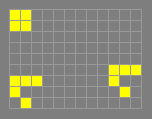A memory register whose value is stored as the
position of a block. The block can be moved by means of glider
collisions. See block pusher for an example.
In Conway's original formulation (as part of his proof of the
existence of a universal computer in Life) two gliders were used to
pull the block inwards by three diagonal spaces, as shown below, and
thirty gliders were used to push it out by the same amount.

Dean Hickerson later greatly improved on this, finding a way to
pull a block inwards by one diagonal space using 2 gliders, and push
it out the same distance using 3 gliders. In order for the memory to
be of any use there also has to be a way to read the value held. It
suffices to be able to check whether the value is zero (as Conway
did), or to be able to detect the transition from one to zero (as
Hickerson did).
Dean Hickerson's sliding block memory is used in Paul Chapman's
URM, and the key salvos from it are used in several other complex
constructions, such as David Bell's Collatz 5N+1 simulator and Adam
P. Goucher's pi calculator and Spartan
universal computer-constructor.









